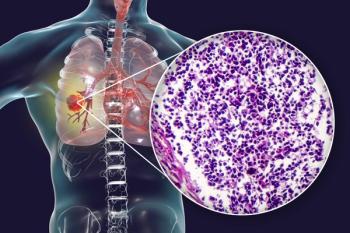
- Oncology NEWS International Vol 8 No 1
- Volume 8
- Issue 1
Taxol May Improve Survival in Advanced NSCLC
ATHENS-Patients with inoperable non-small-cell lung cancer (NSCLC) who receive paclitaxel (Taxol) together with best supportive care survive significantly longer than those managed with best supportive care alone, according to results from a phase III, randomized trial conducted at six sites in the United Kingdom and Canada, and presented at the European Society for Medical Oncology (ESMO) congress.
ATHENSPatients with inoperable non-small-cell lung cancer (NSCLC) who receive paclitaxel (Taxol) together with best supportive care survive significantly longer than those managed with best supportive care alone, according to results from a phase III, randomized trial conducted at six sites in the United Kingdom and Canada, and presented at the European Society for Medical Oncology (ESMO) congress.
Whats more, reported investigator Malcolm Ranson, MD, of Christie Hospital, Manchester, UK, the improvement in survival was achieved without the severe toxicity associated with cisplatin (Platinol)-based regimens.
The design of the trial was simple and pragmatic, Dr. Ranson said. Enrollees were assigned to undergo treatment with 10 cycles of paclitaxel, 200 mg/m² over 3 hours every 21 days, coupled with such supportive measures as palliative radiotherapy, steroids, antibiotics, analgesics, and antiemetics, or to receive best supportive care alone. The average time elapsed between diagnosis and entry into the study was 1 month.
The 157 study participants were stratified according to whether they had stage IV NSCLC (just over half of patients) or stage IIIB disease. More than 80% had an ECOG performance status of 0 or 1, while a minority had a performance status of 2. As would be expected in a lung cancer trial, three-quarters of enrollees were male, and roughly half were over the age of 65.
All patients were required to have measurable disease, no previous radiotherapy within the preceding 2 months, and no prior chemotherapy. The most frequent histologic diagnoses were squamous cell carcinoma and adenocarcinoma.
Dose intensity was well maintained in the study, and, overall, only 11% of cycles required dose modification, Dr. Ranson said. In fact, he pointed out, 80% of patients received greater than 90% of the planned dose intensity. The median number of chemotherapy cycles was five.
The overall response rate was 15%, which was slightly lower than that observed in preliminary phase II trials of paclitaxel in NSCLC. In more than half of patients, the disease remained stable during chemotherapy.
The main conclusion of the study, Dr. Ranson said, was a significant overall survival benefit for the paclitaxel-containing arm. The addition of paclitaxel to best supportive care boosted median survival from 4.8 months to 6.8 months (P = .0373), he said. Paclitaxel likewise delayed the time to progression to 3.9 months, in contrast to the very brief 0.5-month time to progression documented in the best supportive care group.
Severe myelosuppression developed in fewer than 10% of patients assigned to chemotherapy. Overall, 10% of patients in the chemotherapy arm developed grade 3-4 infection, compared to 3% of patients in the best supportive care arm, Dr. Ranson noted. He stressed, however, that this difference may have reflected a time bias, since paclitaxel-treated patients remained in the study for a median of 50% longer than did individuals who received only palliative treatment.
The most prominent side effect was grade 3-4 arthralgia and myalgia, which occurred in 22% of paclitaxel-treated patients and in 4% of those assigned to supportive care.
Quality of life, as measured by the Rotterdam Symptom Checklist, was comparable in both treatment groups. Data analysis was complicated by the fact that patients receiving paclitaxel were living longer and were 10% more likely to be completing their quality of life questionnaires, Dr. Ranson said.
Irrespective of treatment assignment, the investigators documented a steep fall-off in quality of life, particularly in physical functioning, among patients who remained in the study for less than 15 weeks, compared with those who continued for between 15 and 33 weeks.
Articles in this issue
almost 27 years ago
Pittsburgh to Build New Cancer Centeralmost 27 years ago
NCI Initiates Two High-Priority Tobacco Research Programsalmost 27 years ago
Breast Cancer Stamp Sells Wellalmost 27 years ago
Hospital Strategies To Prevent Invasive Aspergillosis Spreadalmost 27 years ago
‘Cancer Patients Should Be Assertive, Know Their Rights’almost 27 years ago
EBCTCG Update of Adjuvant Treatment for Early Breast Canceralmost 27 years ago
Younger Breast Cancer Patients at Increased Risk of Recurrencealmost 27 years ago
Six Named to National Cancer Advisory Boardalmost 27 years ago
Trial Uses Vitamin A To Prevent Lung Cancer in Former Smokersalmost 27 years ago
‘Medical School Curriculum Must Include Palliative Care’Newsletter
Stay up to date on recent advances in the multidisciplinary approach to cancer.


















































































